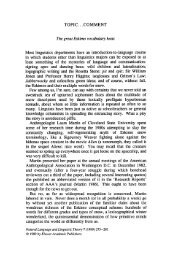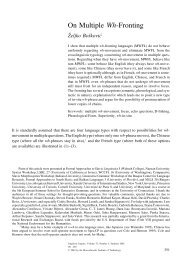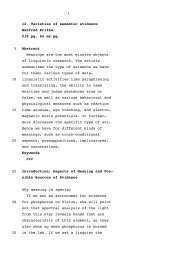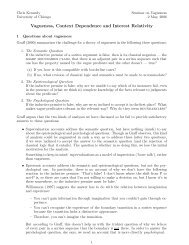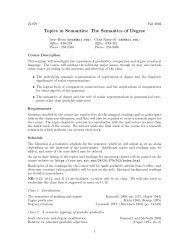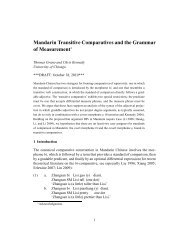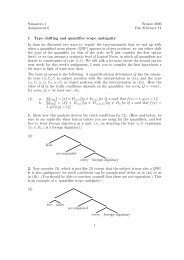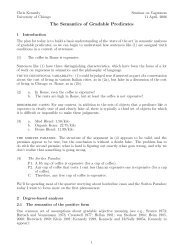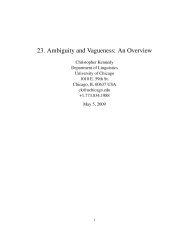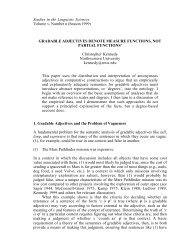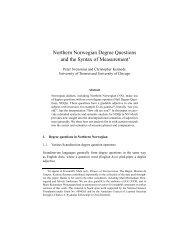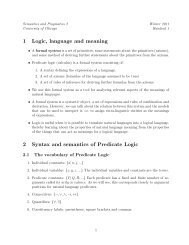On the natural history of negative polarity items - Syntax, Semantics ...
On the natural history of negative polarity items - Syntax, Semantics ...
On the natural history of negative polarity items - Syntax, Semantics ...
You also want an ePaper? Increase the reach of your titles
YUMPU automatically turns print PDFs into web optimized ePapers that Google loves.
Daniel Velleman, David Beaver, Edgar <strong>On</strong>ea, Dylan Bumford, Emilie Destruel & Elizabeth Coppock<br />
It-clefts are IT (Inquiry Terminating) Constructions<br />
We analyze <strong>the</strong> semantics <strong>of</strong> a range <strong>of</strong> constructions which we refer to as Inquiry Terminating<br />
(IT) constructions. In English, <strong>the</strong>se include it-clefts and exclusives such as only, just and mere(ly).<br />
Despite <strong>the</strong>ir di erences, IT constructions have much in common. We claim <strong>the</strong>y are always focussensitive,<br />
have closely related semantics, and have a uniform discourse function: <strong>the</strong>y always mark<br />
utterances that give a complete answer to (what <strong>the</strong> speaker takes to be) <strong>the</strong> Current Question<br />
(CQ). We give a new account <strong>of</strong> <strong>the</strong> meaning <strong>of</strong> clefts that captures both <strong>the</strong>ir similarities and <strong>the</strong>ir<br />
di erences to o<strong>the</strong>r IT constructions.<br />
Explananda Surface similarities between it-clefts and exclusive sentences are easy to see. Both<br />
“It is X that P” and “<strong>On</strong>ly XP” require an intonational focus somewhere in X, and both are used<br />
when XPand nobody else P. But <strong>the</strong>re are significant di erences as well. Some are shown in<br />
<strong>the</strong> following minimal pairs, which show changes in acceptability when an exclusive sentence is<br />
replaced by a cleft.<br />
(1) a. Not only did Larry laugh, but Mary laughed too.<br />
b. #It wasn’t Larry who laughed, but Mary laughed too.<br />
(2) a. Mary ate pizza and she only ate pizza.<br />
b. #Mary ate pizza and it was pizza she ate. (cf. Horn 1981)<br />
(3) Alice: <strong>On</strong>ly Larry laughed.<br />
#Bob: Yes, but Mary laughed too.<br />
(4) Alice: It was Larry who laughed.<br />
Bob: Yes, but Mary laughed too.<br />
<strong>On</strong> our account, <strong>the</strong> similarities are not accidental, but are due to <strong>the</strong> uniform semantics outlined<br />
below. The di erences are due to di erences in at issueness between <strong>the</strong>ir semantic components.<br />
The min-max approach to IT-constructions We adopt and extend <strong>the</strong> approach <strong>of</strong> Coppock and<br />
Beaver (2011), on which <strong>the</strong> meanings <strong>of</strong> exclusives are specified in terms <strong>of</strong> two focus-sensitive<br />
operators, maxS and minS .(CQS indicates <strong>the</strong> Current Question, modeled per Roberts 1996 as a<br />
set <strong>of</strong> propositions; <strong>the</strong> relations ( S ) and (>S ) indicate a salient partial ordering <strong>of</strong> <strong>the</strong> alternatives<br />
in CQS . Throughout, a subscripted S indexes <strong>the</strong> current context.)<br />
(5) a. minS (p) = w . ⌃p⇤ ⇥ ⇤ ⇤<br />
⌅ CQS p (w) ⌥ (p S p) ⇤<br />
b. maxS (p) = w . ⇧p⇤ ⇥ ⇤ ⌅ CQS (p >S p) ⇥ ¬p⇤ (w) ⇤<br />
We extend this account by showing that <strong>the</strong> meanings <strong>of</strong> all it-constructions — clefts as well<br />
as exclusives — can be captured in <strong>the</strong>se terms, as exemplified in (6a–b).<br />
(6) a. onlyS (p) = w : minS (p)(w) . maxS (p)(w)<br />
b. cleftS (p) = w : maxS (p)(w) . minS (p)(w)<br />
<strong>On</strong>e di erence between <strong>the</strong> two operators is apparent: onlyS (p) presupposes what cleftS (p) asserts,<br />
and vice versa. There is one fur<strong>the</strong>r important di erence. ‘<strong>On</strong>ly’ can make salient several<br />
di erent orderings <strong>of</strong> alternatives (including e.g. ordering in terms <strong>of</strong> rank or importance); a cleft<br />
makes salient one particular ordering, consisting <strong>of</strong> a boolean lattice among alternatives.<br />
Advantages <strong>of</strong> this approach There are several advantages to our account <strong>of</strong> clefts. First, it increases<br />
<strong>the</strong> generality <strong>of</strong> <strong>the</strong> min-max approach, and highlights a previously unremarked similarity<br />
among what we are calling IT-constructions. But also, it solves several empirical problems with<br />
earlier accounts.<br />
The first problem concerns projection. Much evidence suggests that <strong>the</strong> exhaustivity <strong>of</strong> a cleft



